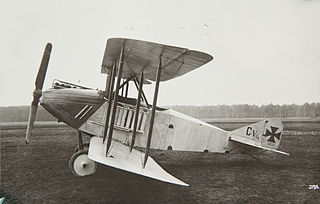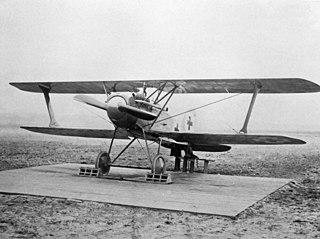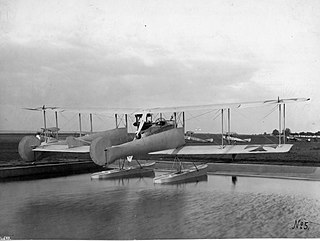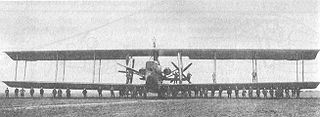| C.VIII | |
|---|---|
 | |
| Ago C.VIII with 2-bay struts | |
| Role | Reconnaissance |
| Manufacturer | AGO Flugzeugwerke |
| First flight | 1917 |
| Status | prototype only |
| Number built | 2 |
The AGO C.VIII was a German reconnaissance aircraft built by AGO Flugzeugwerke during World War I.
| C.VIII | |
|---|---|
 | |
| Ago C.VIII with 2-bay struts | |
| Role | Reconnaissance |
| Manufacturer | AGO Flugzeugwerke |
| First flight | 1917 |
| Status | prototype only |
| Number built | 2 |
The AGO C.VIII was a German reconnaissance aircraft built by AGO Flugzeugwerke during World War I.
The C.VIII was a derivative of the AGO C.IV with a Mercedes D.IVa. Only a single prototype was built. [1]
Data from German Aircraft of the First World War [2] [3]
General characteristics
PerformanceArmament

The AEG C.V was a prototype two-seat biplane reconnaissance aircraft of World War I. Designed to use a more powerful engine than previous AEG C-class reconnaissance aircraft, results were disappointing enough that further development was cancelled.

The AEG C.VII was a prototype two-seat biplane reconnaissance aircraft of World War I. It was developed from the C.IV but did not enter production. The C.VII was tested with two different wing arrangements, one with slightly tapered single bay wings and another with sharply swept upper wing.

The AEG G.V was a biplane bomber aircraft of World War I, a further refinement of the AEG G.IV. The type saw limited production before the Armistice, and never entered operational service. It featured a 600 kg (1,320 lb) bombload.

The Albatros D.IV was an experimental German fighter aircraft built and tested during World War I.

The Albatros D.X was a German prototype single-seat fighter biplane developed in 1918 in parallel with the Albatros D.IX.

The Albatros D.XII was a German single-seat fighter biplane first flown in March 1918. It was the last of the Albatros fighters completed and flown before the end of World War I and had the same slab-sided fuselage seen on the Albatros D.X.

The AGO C.II was a German reconnaissance biplane of World War I. It was essentially a slightly redesigned version of the manufacturer's C.I design with a more powerful engine and 3-bay wings.

The AGO C.IV was a First World War German biplane reconnaissance aircraft.

The Hannover CL.III was a German military aircraft of World War I. It was a two-seat multi-role aircraft, primarily used as a ground attack machine. Like the other Hannover "light-C-class", or "CL" designated aircraft designed by Hermann Dorner, it included an unusual biplane tail, allowing for a greater firing arc for the tail gunner. Until the introduction of the aircraft, such tails had only been used on larger aircraft.

The Fokker M 10 was a two-seater reconnaissance / fighter-trainer biplane with single-bay wings equipped with wing-warping controls for roll, powered by a 7-cylinder 80 hp Oberursel U.0 engine. Several M 10 aircraft were purchased by the Imperial and Royal Aviation Troops of Austro Hungary.
The Gotha G.VII. a.k.a.GL.VII, was a bomber aircraft produced in Germany during the final months of World War I. With the strategic bombing campaign effectively over, it was intended to be a high-speed tactical bomber with a secondary reconnaissance capability. It was a conventional two-bay biplane design with tractor-mounted engines, and a conventional empennage with twin fins and rudders. The bombardier's position in the nose of the aircraft that had featured on earlier Gotha designs was removed, and the nose of the aircraft severely truncated and fitted with a streamlined nose-cone. This allowed the engines to be located further inboard than on previous designs, bringing them closer to the aircraft's centreline and therefore minimising the effects of asymmetric thrust in the event of an engine failure. The engine nacelles also featured careful streamlining.

The Gotha WD.3 was a pusher reconnaissance floatplane built in prototype form in Germany in 1915.

The Gotha WD.7 was a reconnaissance floatplane developed in the German Empire during World War I.

The Siemens-Schuckert R.VIII was a bomber aircraft designed and built in Germany from 1916.

The Rumpler C.X, produced under the company designation Rumpler 8C 14, was a German two-seat observation aircraft. It was developed from the earlier Rumpler 8C 13 prototype by Rumpler in early 1918. The prototype had a similar wing design to the Rumpler C.VII, powered by a 260 hp (194 kW) Mercedes D.IVa engine and was later powered by a 240 hp (179 kW) Maybach Mb.IVa. The C.X had the highest top speed and service ceiling of all German C-type aircraft and an order was placed for the aircraft in August 1918, but few were built and tested before the war ended.
The Friedrichshafen N.I was a German prototype night bomber built by Friedrichshafen during World War I.
The Germania C.I was a two-seat general-purpose biplane built by Germania Flugzeugwerke during World War I.
The LVG C.VIII was a prototype reconnaissance aircraft built in Germany during World War I.
The LFG Roland C.VIII was a German reconnaissance aircraft of World War I. It was manufactured by Luft-Fahrzeug-Gesellschaft G.m.b.H.
The NFW E.II was a fighter aircraft built in Germany during World War I.
| Wikimedia Commons has media related to AGO C.VIII . |